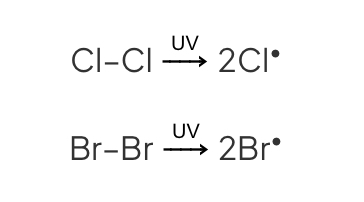Alkanes
1/30
There's no tags or description
Looks like no tags are added yet.
Name | Mastery | Learn | Test | Matching | Spaced |
|---|
No study sessions yet.
31 Terms
How is crude oil separated?
Fractional distillation
How is petroleum separated?
Fractional distillation
Process: Fractional distillation
crude oil heated to form a vapour
Gas passes into fractionating column with negative temperature gradient
Fractions condense at a height where the temperature is lower than their boiling point
Order of compounds in the fractionating column

Cracking
breaking c-c bonds in log chain hydrocarbons into short chain hydrocarbons
Economic reasons for cracking
most useful fractions contain shorter chain hydrocarbons
Most in demand “””””
Thermal Cracking Condition
Temperature: 700-1200K
Pressure: 7000kPa
Thermal cracking mostly produces
high percentage of alkanes
Catalytic Cracking Conditions
Temperature: 720K
Pressure: 5atm 9(mild)
Catalyst: Zeolite catalyst
Catalytic cracking mostly produces
Motor fuels
Aromatic hydrocarbons
Features of zeolites
honeycomb structure with large SA
Benefits of catalytic cracking
catalytic cracking is cheaper
Lower pressure used
Complete Combustion
sufficient oxygen present
→ carbon dioxide + water
Incomplete Combustion
insufficient oxygen
→ carbon monoxide/carbon (soot(solid)) + water
Pollutants of internal engine combustion
carbon monoxide
Nitrogen oxides
Sulphur dioxide
Carbon Monoxide as a pollutant
a result of incomplete combustion of petrol vapour
Sulphur dioxide as a pollutant
sulphur converted to sulphur dioxide
(Unless removed from atmosphere) forms sulphuric (IV) acid
Forms acid rain
Flue gases
Mixture of waste gases
Removal of sulphur dioxide
using calcium oxide/ calcium carbonate in acid-base reaction
Nitrogen Oxides as pollutants
nitrogen has a triple bond
requires a lot of energy to break
High temperatures of engine provide enough energy
Equation for nitrogen oxides

Nitric acid formation
nitrogen monoxide oxidised to nitrogen dioxide
Nitrogen dioxide reacts with atmosphere to form nitric acid
4NO2(g) + 2H2O(l) + O2 → 4HNO3(aq)
Catalytic converter
platinum catalyst used in catalyst converters
Nitrogen oxides oxidise carbon monoxide to carbon dioxide and are themselves reduced

What happens to unburnt hydrocarbons in the catalytic converter?
they are oxidised to carbon dioxide and water
Nitrogen monoxide removed from catalytic converters
when reacted with octane

Chlorination of Alkanes Steps
FREE RADICAL SUBSTITUTION
Initiation
Propagation
Termination
Initiation
UV radiation provides energy to break chlorine molecule into 2 chlorine free radicals

First propogation
chlorine radical reacts with alkane
Halogen halide + alkyl radical

Second Propogation
Alkyl radical reacts with halogen molecule
→ Halogenoalkane + chlorine radical

Termination
Requirements for free radicals substitution
UV Radiation